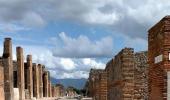Cairo is about leisurely sailing on the Nile, shopping for cottons, tucking into the most amazing meat and vegetarian/vegan eats and being transported back in time, amid the great pharaohs, discovers Tapan Joshi.

Our trip to Egypt was a case of Jaate the Japan, pahuch gaye Chin.
Wanting to escape a drenched Mumbai for a few days, I had Bali on my mind when the travel agent suggested Egypt.

The Indian middle class' love for foreign travel is now globally famous and Egypt has joined the bandwagon of nations that have partnered with the local tour operators to aggressively sell its Nile, its pyramids and its pharaohs.

Cairo
The first thing one notices in Cairo, the capital city, are the endless rows of decrepit buildings. All of them six or seven-storey structures, built in Soviet-era style, of the same colour, ugly to look at.
The walls of some of the buildings are decorated with murals of President Abdel Fattah el-Sisi hugging Xi Jinping, underlining China's growing influence in northern Africa.

Things to do in Cairo: Walk around the famous Tahrir Square, which became the focus of the world during the 2011 Egyptian revolution and then president Hosni Mubarak's subsequent resignation.
Enjoy a strong coffee at one of the French-influenced cafes around Tahrir Square. Or venture into the crowded bazaars nearby, which are very similar to the lanes around Crawford Market in Mumbai.
Buy dates, dry fruits, dark chocolates, and excellent yet cheap cotton clothes from the handcarts (Egypt once grew and still produces some of the best quality cottons in the world) and oh, rotis (you notice lots of people selling just rotis of various sizes).

In Cairo, you are never far from the Nile and it's always a good idea to move away from the terrible traffic in the downtown and hop onto a boat for a leisurely ride watching the sun go down.
Language Issue: English is not a language that an average Egyptian learns in school and tourists with no knowledge of Arabic will have a huge problem dealing with the locals unless accompanied by a tour guide.
Friendly locals: Language problems aside, Egyptians in general have great affinity towards Indians. It could be because both the Egyptian and the Indian civilisations are among the oldest, or because we look somewhat similar...
But mention 'India' in the streets of Cairo and you'll be greeted with wide smiles. Just say 'Shukran (Thank you)', when greeted and you'll probably get a hug.

The Pyramids
One of the primary reason why people travel to Egypt is to see one of the last-standing wonders of the ancient world. As splendid as they ares a few pointers:
- There are three main pyramids and you can enter the biggest of the three, called the Great Pyramid, which is around 450 ft tall (the tallest building in ancient and middle world).
- It requires a great deal of fitness to actually enter any of the pyramids. The entrance is from the third storey, and those with bone/muscle/foot issues or breathing problems should not even think about it.
- A single ticket to enter the pyramid costs about $20.
- It gets extremely claustrophobic inside the pyramid.
- And no, Cleopatra, the famous queen of Egypt, is not buried in there. Nobody knows where her tomb is located.

The pyramids, and the Great Sphinx, are located in a massive compound in the middle of the desert in Giza, about a 30-minute drive from Cairo. The pyramids are truly magnificent to look at.
It's perfectly fine if you can only do one; just walk around them and you'll be fascinated at what the human mind and spirit could achieve more than 4,000 years ago.

Yuya was a powerful ancient Egyptian courtier during the 18th dynasty of Egypt (circa 1390 BC). Photograph: Tapan Joshi


Museums that should not be missed: Definitely visit two museums -- the Grand Egyptian Museum in Giza, which is still in the making and will be the biggest museum of its kind across the globe, and the old Egyptian Museum.
You'll be transported back in time, amid the great pharaohs, and you'll marvel at the arts and skills of the ancient Egyptians.



The complete Tutankhaum collection at the Grand Museum will have you gaping in awe.

Important to note: Egypt has a very relaxed policy towards alcohol. You will find pubs and bars located in most hotels in downtown Cairo. Home/room delivery of alcohol is also available.

Where to eat: Head for the Khanel-Khalili bazaar in Cairo. The kebabs and meat-filled flatbreads are superb and so is the widely-available vegetarian fare (like mezze starters or falafel or koshary/kushari, a rice-lentil-macaroni-tomato sauce dish).

Indian food is available almost everywhere, but get a little adventurous and try a local delicacy made from stuffed pigeon called Hamammahshi. It's delicious, trust me.
Alexandria
Our next stop was Alexandria on the Mediterranean coast, a city founded by Alexander the Great, hence the name.
Alexandria is Egypt's second largest city, about a three-hour drive from Cairo. By the way: Egypt's highways are truly world-class.

Turn left or right in Alexandria and you'll find yourself swarmed by India-made autorickshaws, many of them driven by women in hijab.
The charming old city is dotted with tram lines and is home to the famous Pompey's Pillar, set up in honour of the Roman emperor Diocletian around 300 AD, and the famous catacombs of Kom El Shoqafa.
Things to do in Alexandria: The city has a fascinating Greek-Roman culture. Walk the bylanes and buy local fruits and bread. Both are delicious.
If you like seafood, you have come to the right place. The prawns especially are large, sweet, and juicy. Have them grilled in front of you.
Visit the waterfront. It will remind you of Mumbai'S Marine Drive promenade. There are rows of small cafes in front of the waterfront. Grab a table, take out a book, and watch the world go by.

Egypt: How to get there
Egypt Air operates a direct flight to Cairo thrice a week from Mumbai. For more details have a look at its Web site. It's a six-hour flight and tourist visas are easily available.
Egypt does not impose any dress code on anyone.
One Indian rupee equals around 0.58 Egyptian pound.
It's a meat eaters' paradise, but vegetarians and vegans have plenty of options too.
When to travel: The weather in Egypt is pleasant from October to March. Avoid travel between June and September, when it's very hot.
Hotels: While budget hotels are available all over the country, it is advisable to stay in four/five-star properties. Quality hotels in Cairo and other Egyptian cities are not too expensive, and the tariff covers breakfast.
Feature Presentation: Ashish Narsale/Rediff.com
Lead Image: Asmaa Waguih/Reuters












 © 2025
© 2025